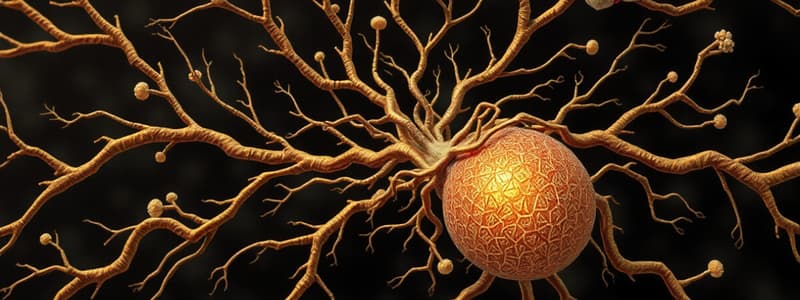Podcast
Questions and Answers
If a developing embryo experienced disruption during the formation of the nerve cord, which of the following systems would be most directly affected?
If a developing embryo experienced disruption during the formation of the nerve cord, which of the following systems would be most directly affected?
- The digestive system, affecting the formation of the stomach and intestines.
- The central nervous system, potentially leading to brain and spinal cord abnormalities. (correct)
- The circulatory system, impacting heart and blood vessel development.
- The respiratory system, primarily influencing lung development.
A researcher is studying the development of the central nervous system in a model organism. What specific structure should they focus on during the early embryonic stages to understand the foundation of the brain and spinal cord?
A researcher is studying the development of the central nervous system in a model organism. What specific structure should they focus on during the early embryonic stages to understand the foundation of the brain and spinal cord?
- The somites, responsible for forming muscle and bone.
- The nerve cord, which develops into the brain and spinal cord. (correct)
- The neural crest, which gives rise to peripheral nerves.
- The notochord, as it induces the formation of the digestive tract.
Which of the following represents the correct developmental sequence in the formation of the central nervous system?
Which of the following represents the correct developmental sequence in the formation of the central nervous system?
- Brain -> Spinal Cord -> Nerve Cord
- Spinal Cord -> Brain -> Nerve Cord
- Nerve Cord -> Spinal Cord and Brain (correct)
- Nerve Cord -> Brain -> Spinal Cord
A genetic mutation disrupts the proper development of the nerve cord in an embryo. Which of the following functions is most likely to be impaired in the developed organism?
A genetic mutation disrupts the proper development of the nerve cord in an embryo. Which of the following functions is most likely to be impaired in the developed organism?
During embryonic development, a group of cells is identified as destined to form the nerve cord. What is the primary fate of these cells?
During embryonic development, a group of cells is identified as destined to form the nerve cord. What is the primary fate of these cells?
Flashcards
Brain
Brain
The part of the central nervous system that controls thought, memory, emotion, touch, motor skills, vision, breathing, temperature, hunger, and every process that regulates our body.
Spinal Cord
Spinal Cord
A long, thin, tubular bundle of nervous tissue and support cells that extends from the brain.
Central Nervous System (CNS)
Central Nervous System (CNS)
The brain and spinal cord collectively.
Study Notes
- The nerve cord develops into the central nervous system.
- The brain is a component of the central nervous system.
- The spinal cord is a component of the central nervous system.
Studying That Suits You
Use AI to generate personalized quizzes and flashcards to suit your learning preferences.



